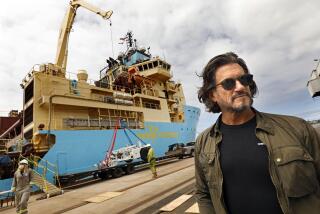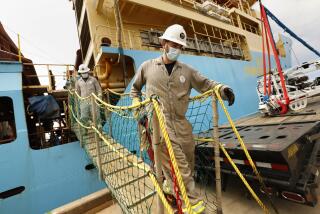High-tech film shows little-known world
- Share via
A new film that’s about to open portrays the wonders and perils to be found at the bottom of the ocean, populated with brightly colored creatures and exciting forms of underwater life. No, we’re not talking about a sequel to “Finding Nemo.”
The Imax film “Volcanoes of the Deep Sea” offers a giant-screen view of what could be called the last frontier, in this case 12,000 feet under the sea, a region of our planet rarely traversed or even seen by humans.
Combining cutting-edge lighting and Imax technology with scientific exploration, the film, opening Sunday at the California Science Center in Exposition Park, depicts volcanic habitats existing in hydrothermal vents in the Mid-Ocean Ridge of the Atlantic and Pacific oceans.
The sights on view include astonishing plumes of thick, black smoke. Six-foot-long tubeworms wave impossibly bright red tips that resemble Max Factored puckering lips. And there’s even a mystery afoot, in the shape of an unusual pattern found in the sediment on the ocean floor, which appears to be the product of an unknown organism.
The film offers unprecedented video-recorded views of hydrothermal vents -- volcanic rock formations, openings in the Earth’s crust out of which spurts water as hot as 750 degrees. Among the many remarkable elements of the vents -- they were first discovered in 1977 during a geological-mapping expedition -- is a thrilling ecosystem, a unique variety of life forms whose existence contradicts the long-held scientific assumption that energy radiated from the sun is necessary to create and sustain life on Earth.
Scientists studying the vents have taken photographs and filmed them, but this was most often done with rudimentary equipment, focusing on specific, narrow areas visited repeatedly for research purposes -- 100 feet in any direction might well have been uncharted terrain. And because only limited means of illumination were possible at such great depths until relatively recently, it was almost impossible to see anything of the vents.
That changed in 1991 when Canadian filmmaker Stephen Low, who has been working in the Imax format for more than 20 years, first went down into the deep to film the wreckage of the Titanic. “There were great improvements around that time in general lighting technology,” he recalls. Working with San Diego-based Deep Sea Power & Light, Low developed an undersea lighting system able to generate 4,400 watts of power.
In this way, a much larger landscape could be captured in Imax’s oversized frames, literally shedding new light on the subject. “It’s a combination of having 50 times the light and 60 or 70 times the resolution,” compared with standard images, Low points out. “Titanica” was released to great acclaim in 1992, and James Cameron used Low’s lighting system in his 1997 movie about the doomed ocean liner. (Cameron also is an executive producer on “Volcanoes.”)
Twice the usual cost
It was while working on “Titanica” that Low got his first glimpse of the hydrothermal vents -- and heard their siren call. “In those days we were filming the Titanic, and we couldn’t go off target. But I knew that we had to go back and film the volcanoes, because, really, that’s a lot more interesting than a shipwreck.”
But Imax-sized filming, whether under the water, in the air or on the ground, is very expensive. Narrated by Ed Harris, “Volcanoes” is just 40 minutes long, yet it cost $8 million. “To shoot a Hollywood film with this kind of equipment and film stock, that is 10 times bigger than 35mm, would cost two to three times more,” Low says.
This perhaps explains why the industry has not more avidly embraced the format and why most Imax films have been nature-based, non-narrative documentaries. “It’s a strange hybrid,” observes Low, “in the sense that on the one hand the productions are fairly simple, but on the other hand, in terms of technology, they’re vastly more expensive than most Hollywood productions.”
Even though “Titanica” offered tantalizing, never-before-seen glimpses of the ocean floor, Low faced obstacles while raising money for “Volcanoes.”
“We were sure that with the big lights and opening up large areas that everyone would be interested,” he remarks. “But we were confronted with people who said, ‘Oh, you’ve already done the deep sea.’ We filmed the Titanic, and that was it in people’s minds. I realized that no one would believe it until we went out and did it.”
Ultimately, “Volcanoes of the Deep Sea” was co-produced by Low’s company and Rutgers University in New Jersey, which has an international reputation in ocean sciences. Sharing Low’s enthusiasm for the venture, Rutgers invited Low and his equipment on five of its already funded dives.
The film was shot over three years (1999-2002) and 22 dives in Alvin, a deep-sea submersible that usually accommodates three people.
However, the 200-pound Imax camera -- it shot from inside the sub -- took up the room of one person, leaving just two in the sub, meaning the cameraman had to sometimes help operate the vehicle, and Alvin’s pilot sometimes was called upon to pull focus.
Dr. Richard Lutz, director of Rutgers’ Center for Deep Sea Ecology and Biotechnology and the film’s science director, participated in the first biological expedition to the hydrothermal vents in 1979 and has journeyed to the bottom of the sea nearly 100 times.
He went on several of the “Volcanoes” dives and is excited about how the film has expanded the boundaries of the underwater “laboratory.” With the flick of a switch, “It opened up a whole new perspective on what we had been studying,” he said in a recent telephone interview.
Thanks to the ultra-high-wattage and the wide Imax field of vision, “we were seeing literally three to four times as far as we’ve ever been able to see. We had been studying the area for over a decade, and suddenly we were able to sit back and look at features we’d never been able to place in the larger context before.”
Besides giving the public its first look at these images, “Volcanoes of the Deep Sea,” Lutz asserts, “absolutely improves the science. Every time I look at the film I see something new.”
*
‘Volcanoes of the Deep Sea’
Where: California Science Center Imax Theater, 700 State St., L.A.
When: Daily beginning Sunday, 10:30 a.m., 12:30 p.m., 2:30 p.m., 4:30 p.m.
Ends: Indefinitely
Price: $4.50 to $7.50
Contact: (213) 744-7400
Running time: 40 mins.
More to Read
Only good movies
Get the Indie Focus newsletter, Mark Olsen's weekly guide to the world of cinema.
You may occasionally receive promotional content from the Los Angeles Times.










